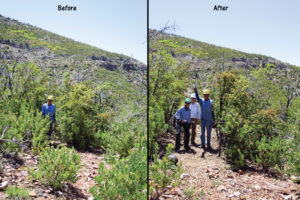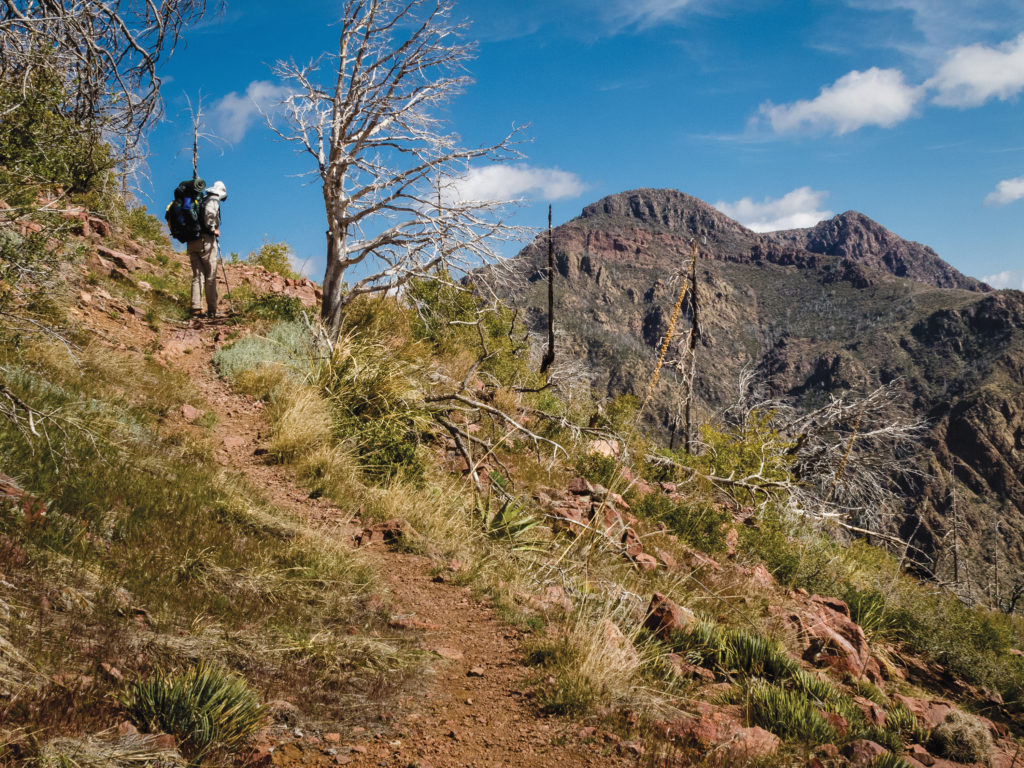By Matthew J. Nelson, Executive Director of the Arizona Trail Association
Adapted from the article, “Mazatzal Restoration Project,” in the Summer 2017 edition of Arizona Trail News.
Of all the trail projects the Arizona Trail Association (ATA) has undertaken over the past five years, none are as impressive as the Mazatzal Restoration Project.
With support from the Tonto, Prescott, and Coronado National Forests, American Conservation Experience, Arizona Conservation Corps, Arizona Wilderness Coalition, and the dedication of over 100 volunteers, we are proud to announce that the 38 miles of the Arizona National Scenic Trail (AZT) through the Mazatzal Wilderness has been transformed.
Before 2016, this remote segment of the AZT received infrequent volunteer maintenance due to its relative inaccessibility and few visitors due to its degrading trail conditions and reputation within the hiking community as a “scary bushwhack.” In addition, numerous forest fires in the Mazatzal Mountains over the past decade caused significant deadfall and erosion.

Before and after of the Mazatzal restoration project on the Arizona Trail. (Photo courtesy Arizona Trail Association)
The fact that the AZT hadn’t been entirely consumed by nature can be attributed to the hard work of a few dedicated ATA volunteers—Joe and John—who’ve probably spent more time in this mountain range with saws and loppers than anyone alive.
Funds from the National Forest Foundation were matched by Pioneer Title Agency and ATA donors to support conservation corps work within priority project areas, with volunteer work events filling in the gaps. One of these events was a weeklong Volunteer Vacation that saw nine hearty souls clearing logs and beating back thick manzanita, oak, and locust overgrowth along 6 miles of trail south of Horse Camp Seep.
Momentum for trail restoration convinced the Tonto National Forest to dedicate funds to support trail restoration on the AZT as well as its connector trails. With access to the heart of the Mazatzals presenting one of the biggest logistical hurdles, the Tonto funded American Conservation Experience (ACE) to clear the Barnhardt Trail, which provides access from a trailhead located near Hwy. 87 to the Mazatzal Divide. This work was necessary in order to allow safe passage of packstock to deliver food, water, tools, and supplies for backcountry hitches.
Once the Barnhardt Trail was passable, ACE was put to work for seven hitches (one hitch = 80 hours of labor). Then, the Bureau of Indian Affairs funded five hitches of an Arizona Conservation Corps Ancestral Lands Crew consisting of Native American youth to work on these connector trails: Deer Creek, Barnhardt, City Creek, Y Bar, and Two Bar Ridge. Later, the Tonto National Forest received funding from 21st Century Service Corps for two more hitches of Arizona Conservation Corps.
Throughout 2016 and 2017, the ATA wrangled volunteers to help on various segments of the project area through organized trail work days. Some were small groups of backpackers spending three days in the field while others were afternoon events engaging local Boy Scouts. In all, approximately 50 conservation corpsmembers contributed 21 weeks of work in support of the project, and volunteers contributed almost 3,000 hours of service.
What was once an overgrown and barely discernable route through a remote wilderness area is now a path that lives up to its designation as a National Scenic Trail. It no longer requires a GPS device to find the tread and a machete to clear the way, and is now a possibility for equestrians. Nearly 200 downed trees were removed from the AZT during the course of this project, and 73 drainage features were improved or added. Most noticeable, however, is the amount of vegetation that was removed from the corridor.
The Mazatzal Mountains will always be wild and rugged—the longest stretch of designated wilderness anywhere along the AZT—but thanks to the support of many valuable partners, now there is a clear path through. If you’ve never been, plan a backpacking trip this autumn. There are few stretches of the AZT as unforgettable as the 36 miles between Mount Peeley and the East Verde River.
Unless otherwise indicated, all material in Pathways Across America is public domain. All views expressed herein are perspectives of individuals working on behalf of the National Trails System and do not necessarily represent the viewpoint of the Federal agencies.
